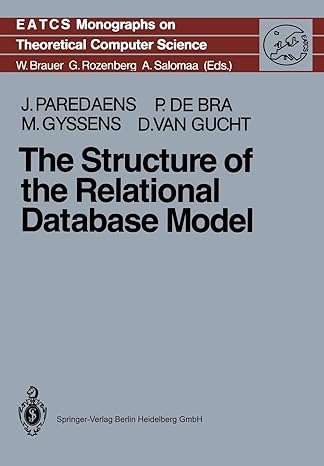What is the solution for this lab with the network application on the cisco packet trcer program
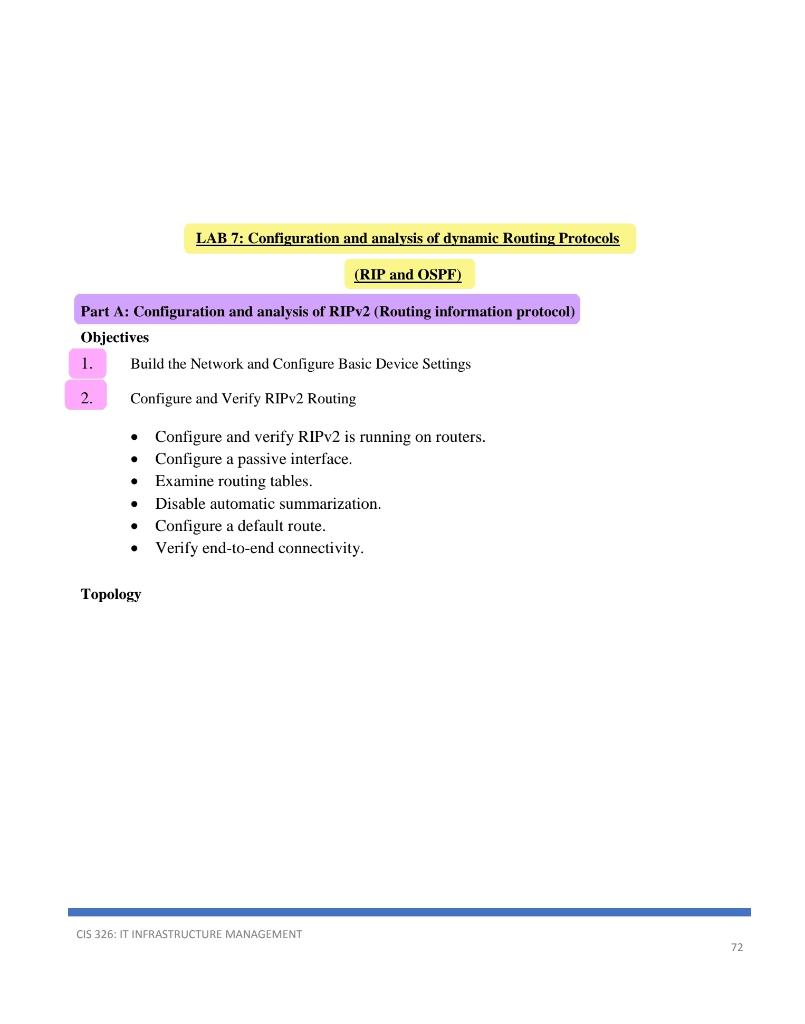
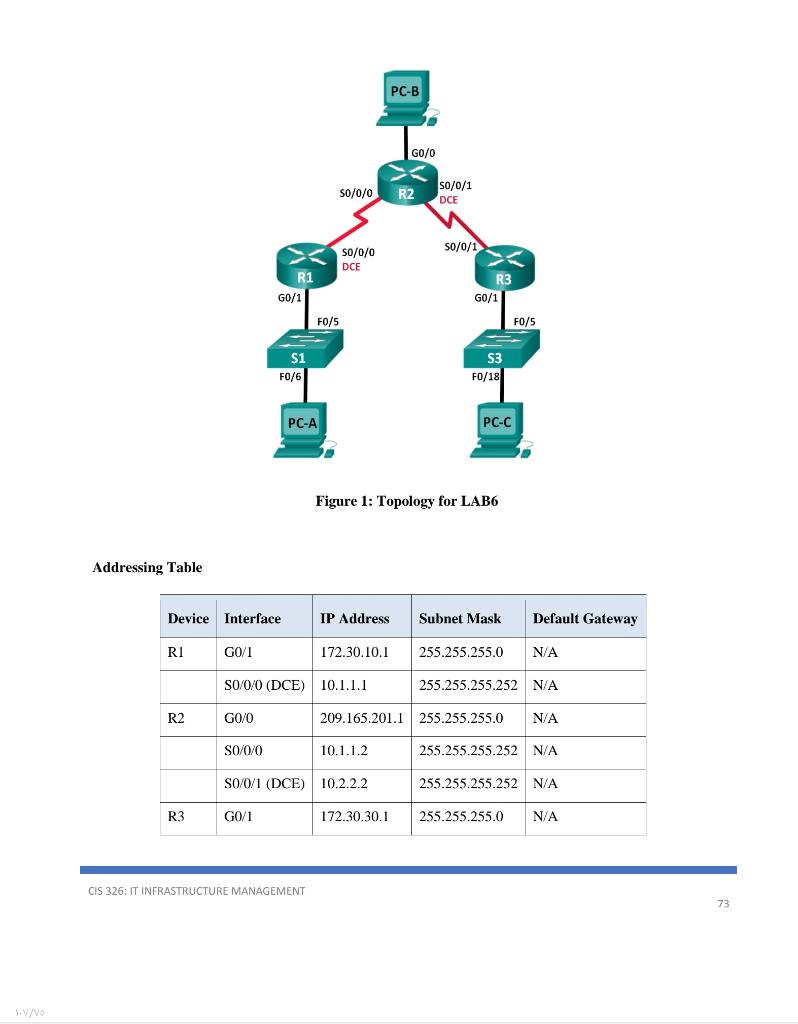
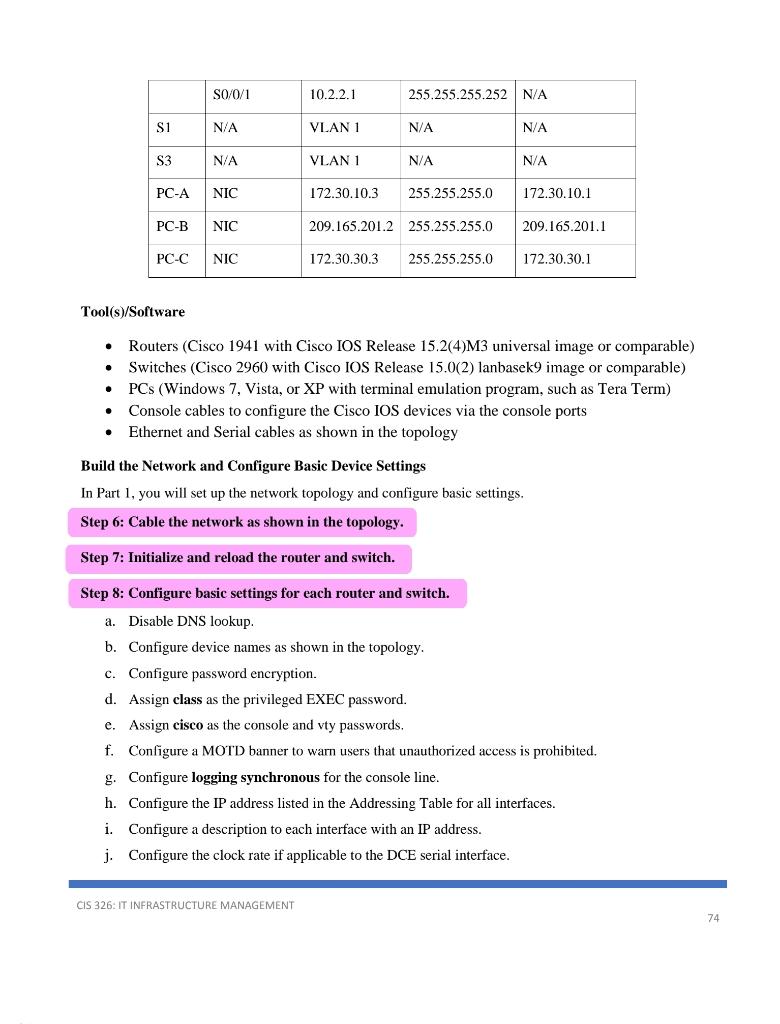
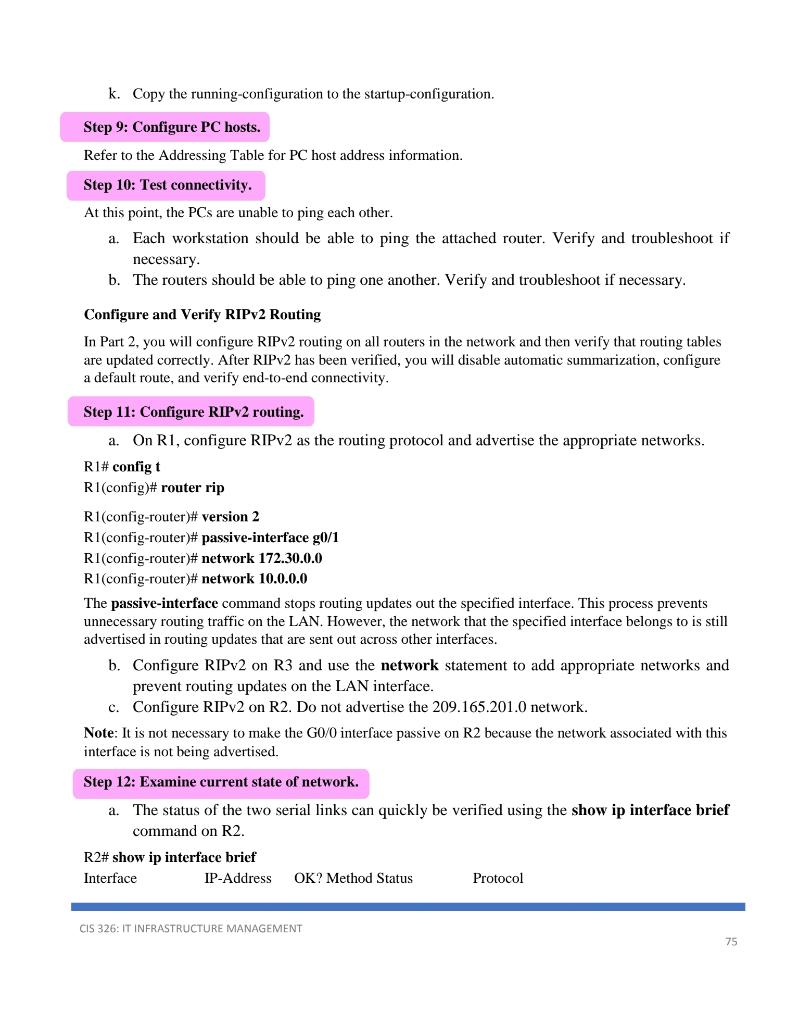
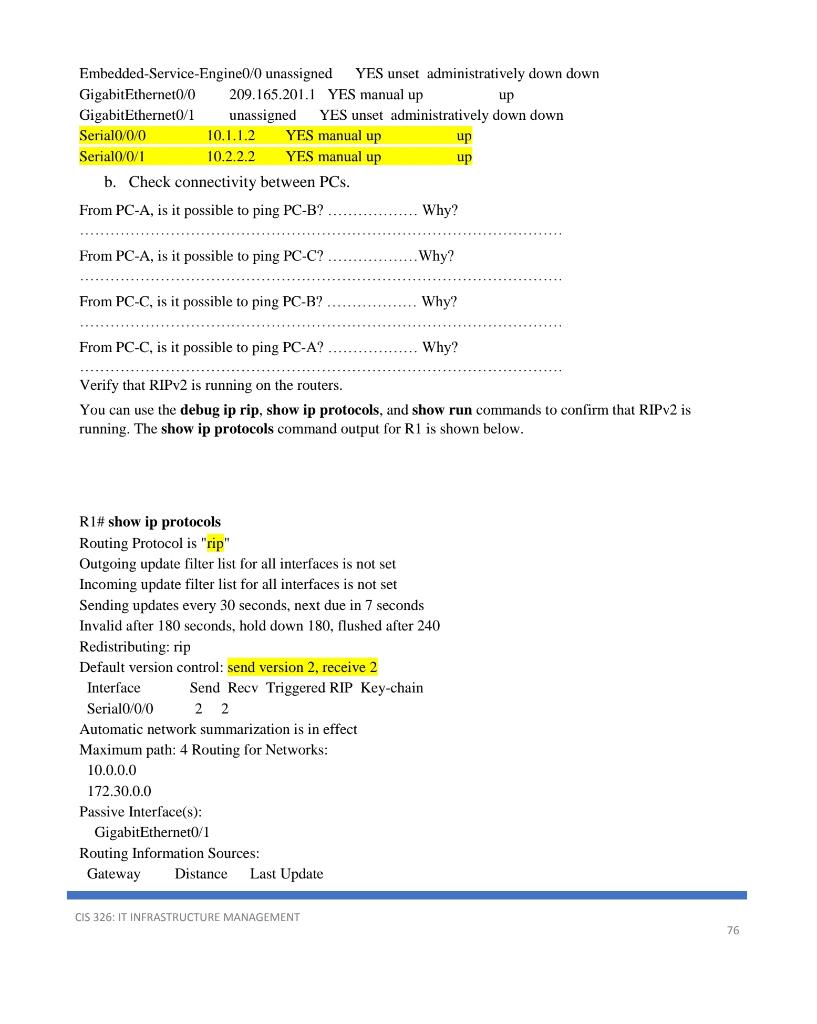
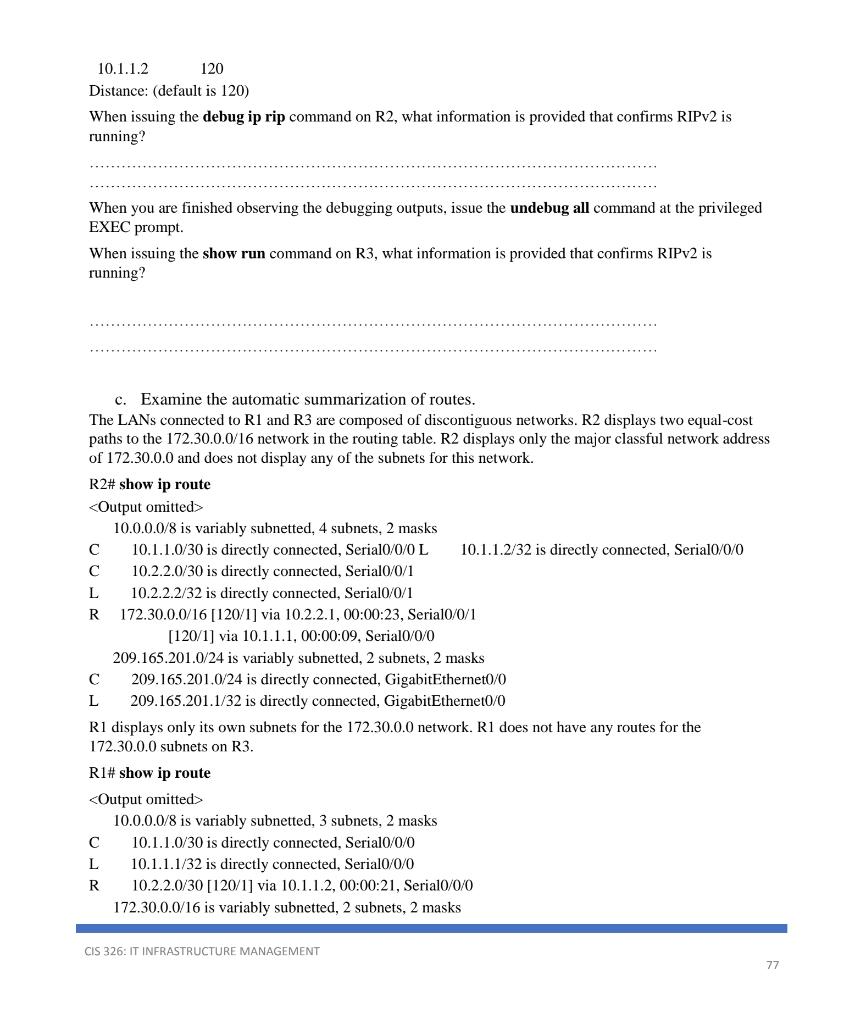
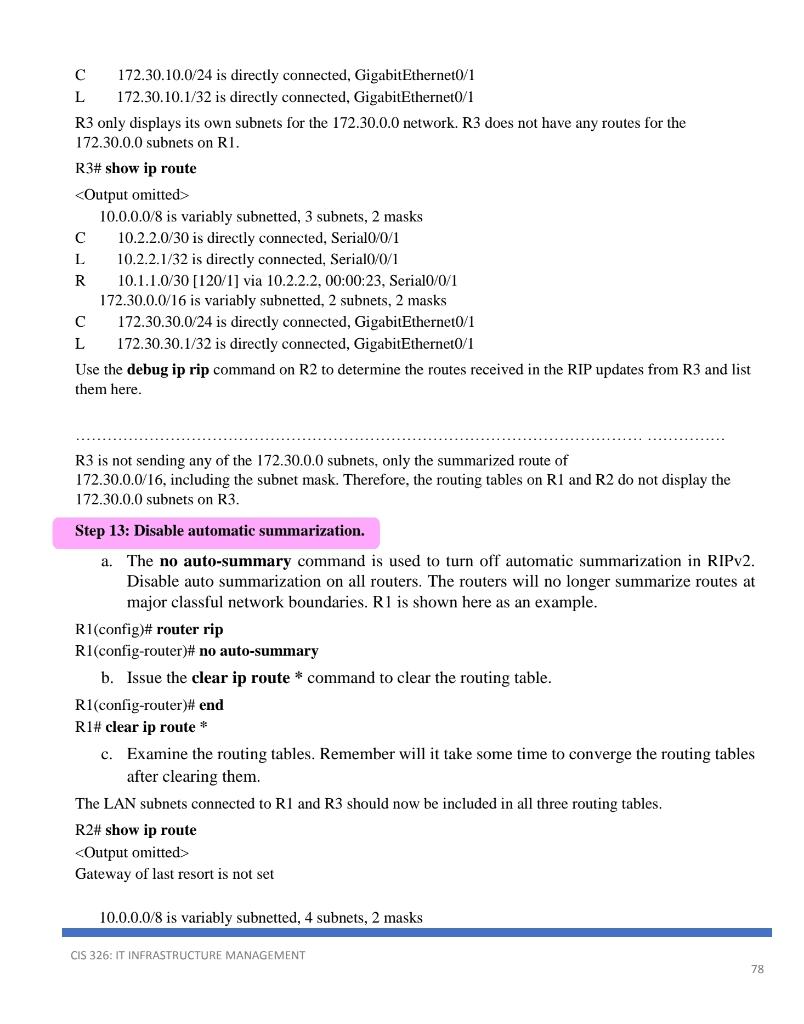

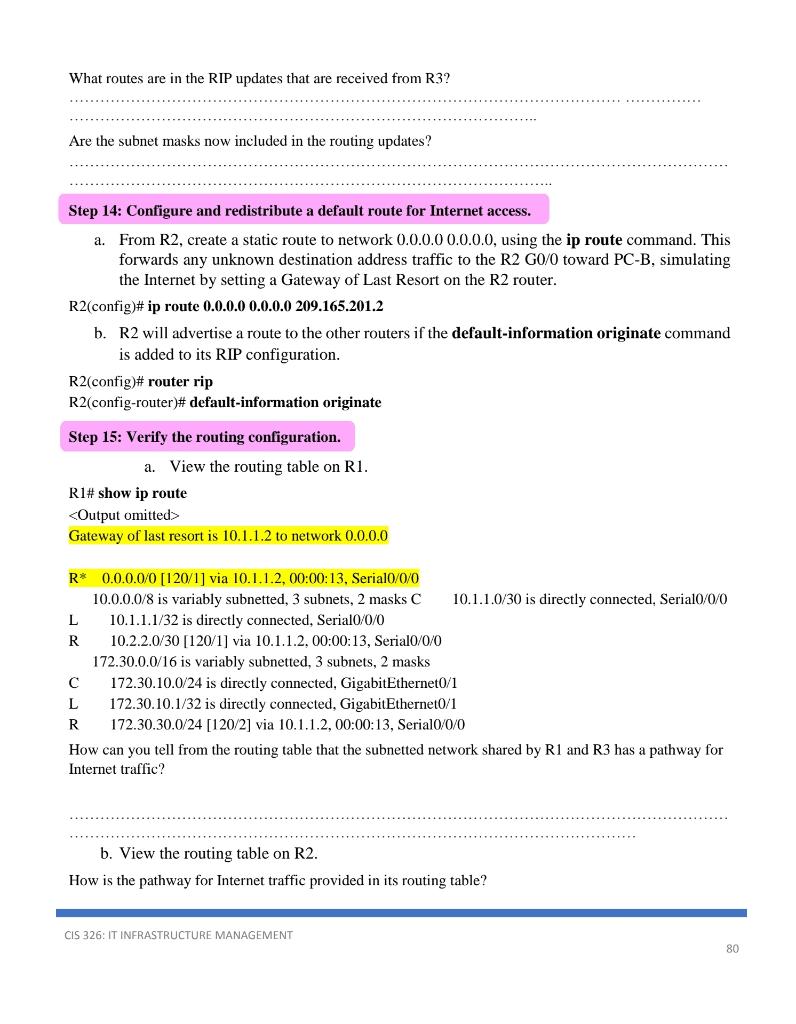
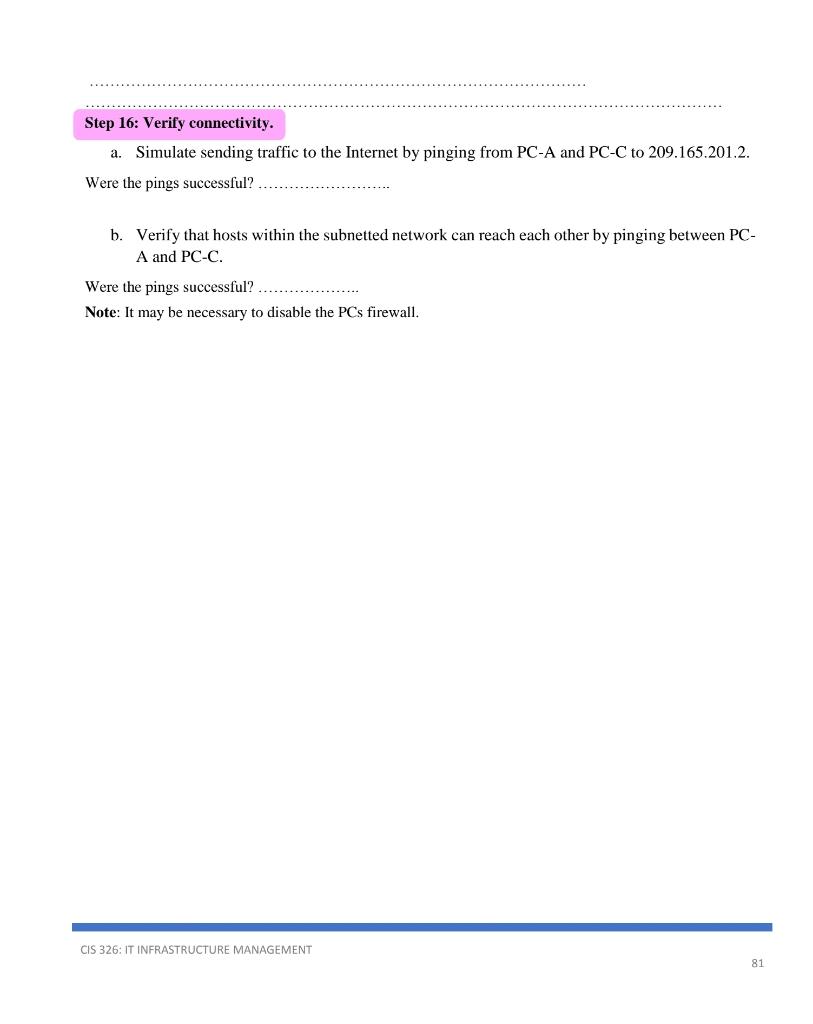
LAB 7: Configuration and analysis of dynamic Routing Protocols Part A: Configuration and analysis of RIPv2 (Routing information protocol) Objectives Build the Network and Configure Basic Device Settings Configure and Verify RIPv2 Routing - Configure and verify RIPv2 is running on routers. - Configure a passive interface. - Examine routing tables. - Disable automatic summarization. - Configure a default route. - Verify end-to-end connectivity. Figure 1: Topology for LAB6 Addressing Table CIS 326: IT INFRASTRUCTURE MANAGEMENT Tool(s)/Software - Routers (Cisco 1941 with Cisco IOS Release 15.2(4)M3 universal image or comparable) - Switches (Cisco 2960 with Cisco IOS Release 15.0(2) lanbasek9 image or comparable) - PCs (Windows 7, Vista, or XP with terminal emulation program, such as Tera Term) - Console cables to configure the Cisco IOS devices via the console ports - Ethernet and Serial cables as shown in the topology Build the Network and Configure Basic Device Settings In Part 1, you will set up the network topology and configure basic settings. Step 6: Cable the network as shown in the topology. Step 7: Initialize and reload the router and switch. Step 8: Configure basic settings for each router and switch. a. Disable DNS lookup. b. Configure device names as shown in the topology. c. Configure password encryption. d. Assign class as the privileged EXEC password. e. Assign cisco as the console and vty passwords. f. Configure a MOTD banner to warn users that unauthorized access is prohibited. g. Configure logging synchronous for the console line. h. Configure the IP address listed in the Addressing Table for all interfaces. i. Configure a description to each interface with an IP address. j. Configure the clock rate if applicable to the DCE serial interface. k. Copy the running-configuration to the startup-configuration. Refer to the Addressing Table for PC host address information. At this point, the PCs are unable to ping each other. a. Each workstation should be able to ping the attached router. Verify and troubleshoot if necessary. b. The routers should be able to ping one another. Verify and troubleshoot if necessary. Configure and Verify RIPv2 Routing In Part 2, you will configure RIPv2 routing on all routers in the network and then verify that routing tables are updated correctly. After RIPv2 has been verified, you will disable automatic summarization, configure a default route, and verify end-to-end connectivity. Step 11: Configure RIPv2 routing. a. On R1, configure RIPv2 as the routing protocol and advertise the appropriate networks. R1 \# config t R1 (config)\# router rip R1(config-router)\# version 2 R1 (config-router)\# passive-interface g 0/1 RI(config-router)\# network 172.30.0.0 R 1(config-router)\# network 10.0.0.0 The passive-interface command stops routing updates out the specified interface. This process prevents unnecessary routing traffic on the LAN. However, the network that the specified interface belongs to is still advertised in routing updates that are sent out across other interfaces. b. Configure RIPv2 on R3 and use the network statement to add appropriate networks and prevent routing updates on the LAN interface. c. Configure RIPv2 on R2. Do not advertise the 209.165.201.0 network. Note: It is not necessary to make the G0/0 interface passive on R2 because the network associated with this interface is not being advertised. Step 12: Examine current state of network. a. The status of the two serial links can quickly be verified using the show ip interface brief command on R2. R2\# show ip interface brief Interface IP-Address CIS 326: IT INFRASTRUCTURE MANAGEMENT Embedded-Service-Engine 0/0 unassigned YES unset administratively down down GigabitEthernet0/0 209.165.201.1 YES manual up up GigabitEthernet0/1 unassigned YES unset administratively down down Verify that RIPv2 is running on the routers. You can use the debug ip rip, show ip protocols, and show run commands to confirm that RIPv2 is running. The show ip protocols command output for R1 is shown below. CIS 326: IT INFRASTRUCTURE MANAGEMENT 76 10.1.1.2 120 Distance: (default is 120 ) When issuing the debug ip rip command on R2, what information is provided that confirms RIPv2 is running? When you are finished observing the debugging outputs, issue the undebug all command at the privileged EXEC prompt. When issuing the show run command on R3, what information is provided that confirms RIPv2 is running? c. Examine the automatic summarization of routes. The LANs connected to R1 and R3 are composed of discontiguous networks. R2 displays two equal-cost paths to the 172.30.0.0/16 network in the routing table. R2 displays only the major classful network address of 172.30.0.0 and does not display any of the subnets for this network. R2\# show ip route Output omitted > 10.0.0.0/8 is variably subnetted, 4 subnets, 2 masks C 10.1.1.0/30 is directly connected, Serial 0/0/0L 10.1.1.2/32 is directly connected, Serial0/0/0 C 10.2.2.0/30 is directly connected, Serial 0/0/1 L 10.2.2.2/32 is directly connected, Serial 0/0/1 R 172.30.0.0/16[120/1] via 10.2.2.1,00:00:23, Serial0/0/1 [120/1] via 10.1.1.1,00:00:09, Serial /0/0 209.165.201.0/24 is variably subnetted, 2 subnets, 2 masks C 209.165.201.0/24 is directly connected, GigabitEthernet0/0 L 209.165.201.1/32 is directly connected, GigabitEthernet0/0 R1 displays only its own subnets for the 172.30.0.0 network. R1 does not have any routes for the 172.30.0.0 subnets on R3. R1\# show ip route Output omitted 10.0.0.0/8 is variably subnetted, 3 subnets, 2 masks C 10.1.1.0/30 is directly connected, Serial 0/0/0 L 10.1.1.1/32 is directly connected, Serial 0/0/0 R 10.2.2.0/30[120/1] via 10.1.1.2,00:00:21, Serial0/0/0 172.30.0.0/16 is variably subnetted, 2 subnets, 2 masks CIS 326: IT INFRASTRUCTURE MANAGEMENT 77 C 172.30.10.0/24 is directly connected, GigabitEthernet0/1 L 172.30.10.1/32 is directly connected, GigabitEthernet 0/1 R3 only displays its own subnets for the 172.30.0.0 network. R3 does not have any routes for the 172.30.0.0 subnets on R1. R3 \# show ip route Output omitted > 10.0.0.0/8 is variably subnetted, 3 subnets, 2 masks C 10.2.2.0/30 is directly connected, Serial 0/0/1 L 10.2.2.1/32 is directly connected, Serial 0/0/1 R10.1.1.0/30[120/1] via 10.2.2.2,00:00:23, Serial0/0/1 172.30.0.0/16 is variably subnetted, 2 subnets, 2 masks C 172.30.30.0/24 is directly connected, GigabitEthernet 0/1 L172.30.30.1/32 is directly connected, GigabitEthernet 0/1 Use the debug ip rip command on R2 to determine the routes received in the RIP updates from R3 and list them here. R3 is not sending any of the 172.30.0.0 subnets, only the summarized route of 172.30.0.0/16, including the subnet mask. Therefore, the routing tables on R1 and R2 do not display the 172.30.0.0 subnets on R3. Step 13: Disable automatic summarization. a. The no auto-summary command is used to turn off automatic summarization in RIPv2. Disable auto summarization on all routers. The routers will no longer summarize routes at major classful network boundaries. R1 is shown here as an example. R1 (config)\# router rip R1(config-router)\# no auto-summary b. Issue the clear ip route * command to clear the routing table. R1(config-router)\# end R1\# clear ip route * c. Examine the routing tables. Remember will it take some time to converge the routing tables after clearing them. The LAN subnets connected to R1 and R3 should now be included in all three routing tables. R2\# show ip route Gateway of last resort is not set 10.0.0.0/8 is variably subnetted, 4 subnets, 2 masks CIS 326: IT INFRASTRUCTURE MANAGEMENT C 10.1.1.0/30 is directly connected, Serial /0/0L 10.1.1.2/32 C 10.2.2.0/30 is directly connected, Serial 0/0/1 L 10.2.2.2/32 is directly connected, Serial0/0/1 172.30.0.0/16 is variably subnetted, 3 subnets, 2 masks R 172.30.0.0/16[120/1] via 10.2.2.1,00:01:01, Serial 0/0/1 [120/1] via 10.1.1.1, 00:01:15, Serial0/0/0 R 172.30.10.0/24[120/1] via 10.1.1.1,00:00:21, Serial 0/0/0 R 172.30.30.0/24[120/1] via 10.2.2.1,00:00:04, Serial 0/0/1 209.165.201.0/24 is variably subnetted, 2 subnets, 2 masks C 209.165.201.0/24 is directly connected, GigabitEthernet 0/0 L 209.165.201.1/32 is directly connected, GigabitEthernet 0/0 R I\# show ip route Gateway of last resort is not set 10.0.0.0/8 is variably subnetted, 3 subnets, 2 masks C 10.1.1.0/30 is directly connected, Serial /0/0 L 10.1.1.1/32 is directly connected, Serial0/0/0 R 10.2.2.0/30[120/1] via 10.1.1.2,00:00:12, Serial0/0/0 172.30.0.0/16 is variably subnetted, 3 subnets, 2 masks C 172.30.10.0/24 is directly connected, GigabitEthernet 0/1 L 172.30.10.1/32 is directly connected, GigabitEthernet0/1 R 172.30.30.0/24[120/2] via 10.1.1.2,00:00:12, Serial 0/0/0 R3\# show ip route Output omitted 10.0.0.0/8 is variably subnetted, 3 subnets, 2 masks C 10.2.2.0/30 is directly connected, Serial 0/0/1 L 10.2.2.1/32 is directly connected, Serial0/0/1 R 10.1.1.0/30[120/1] via 10.2.2.2,00:00:23, Serial0/0/1 172.30.0.0/16 is variably subnetted, 2 subnets, 2 masks C 172.30.30.0/24 is directly connected, GigabitEthernet0/1 L 172.30.30.1/32 is directly connected, GigabitEthernet0/1 R 172.30.10.0[120/2] via 10.2.2.2,00:00:16, Serial /0/1 d. Use the debug ip rip command on R2 to exam the RIP u R2\# debug ip rip After 60 seconds, issue the no debug ip rip command. Are the subnet masks now included in the routing updates? Step 14: Configure and redistribute a default route for Internet access. a. From R2, create a static route to network 0.0.0.0 0.0.0.0, using the ip route command. This forwards any unknown destination address traffic to the R2G0/0 toward PCB, simulating the Internet by setting a Gateway of Last Resort on the R2 router. R 2(config)\# ip route 0.0.0.0 0.0.0.0 209.165.201.2 b. R2 will advertise a route to the other routers if the default-information originate command is added to its RIP configuration. R2 (config)\# router rip R2(config-router)\# default-information originate Step 15: Verify the routing configuration. a. View the routing table on R1. R1\# show ip route Output omitted Gateway of last resort is 10.1.1.2 to network 0.0.0.0 R0.0.0.0/0[120/1] via 10.1.1.2,00:00:13, Serial 0/0/0 10.0.0.0/8 is variably subnetted, 3 subnets, 2 masks C 10.1.1.0/30 is directly connected, Serial 0/0/0 L 10.1.1.1/32 is directly connected, Serial 0/0/0 R 10.2.2.0/30[120/1] via 10.1.1.2,00:00:13, Serial0/0/0 172.30.0.0/16 is variably subnetted, 3 subnets, 2 masks C 172.30.10.0/24 is directly connected, GigabitEthernet0/1 L 172.30.10.1/32 is directly connected, GigabitEthernet 0/1 R 172.30.30.0/24[120/2] via 10.1.1.2,00:00:13, Serial0 /0/0 How can you tell from the routing table that the subnetted network shared by R1 and R3 has a pathway for Internet traffic? b. View the routing table on R2. How is the pathway for Internet traffic provided in its routing table? CIS 326: IT INFRASTRUCTURE MANAGEMENT 80 a. Simulate sending traffic to the Internet by pinging from PC-A and PC-C to 209.165.201.2. Were the pings successful? b. Verify that hosts within the subnetted network can reach each other by pinging between PCA and PC-C. Were the pings successful? Note: It may be necessary to disable the PCs firewall
















